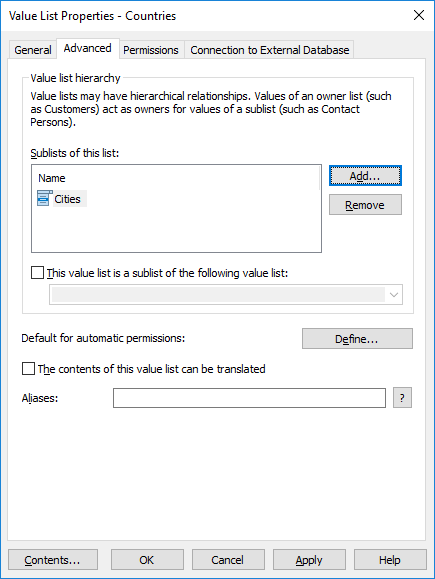Advanced Value List Properties
Value list hierarchy

In the advanced settings, various hierarchical relationships can be defined.
Defining an Internal Hierarchy for a Value List
A value list can be hierarchical in itself, meaning that it can contain items and subitems. A parent item collects related subitems. This way, you can create, for example, a value list containing all drawing types hierarchically. The parent object can be for instance a floor plan, with floor plans in different scales as its subobjects. Regardless of their internal hierarchy, all items in the hierarchical value list represent the same concept (for example, the parent item Floor plan and its subitems Floor plan 1:100 and Floor plan 1:50).
Do the following steps to define an internal hierarchy for a value list:
- Open M-Files Admin.
- In the left-side tree view, expand a connection to M-Files server.
- Expand Document Vaults.
- Expand a vault.
-
Expand Metadata Structure (Flat View) and then select
Value Lists.
Result:The Value Lists list is opened in the right pane.
-
Double-click the value list that you want to edit.
Result:The Value List Properties dialog is opened.
- Open the Advanced tab, and check This value list is a sublist of the following value list check box.
- Using the drop-down menu, select the Same list (defines a value list with internal hierarchy) option.
-
Click the Contents... button.
Result:The Value List Contents dialog is opened.
- Select an item on the list for which you want to create a subitem and click New Subitem.
-
Type in an appropriate name for the new item.
You can also rename the item later by selecting the item in the list and clicking Rename.
- Optional: If you want to create additional subitems, repeat the steps 10 and 11.
- Click Close when you are ready.
Defining a Hierarchical Relationship Between Value Lists
If a parent item and subitems represent different concepts, such as countries and their cities, separate value lists must be created for the items and the value lists must be defined as two hierarchically related value lists. In such a case, the item in the Countries value list (country name) is the owner value for the items in the Cities value list. The Countries value list is then the higher-level list and the Cities list is its sublist.
Do the following steps to define a hierarchical relationship between two value lists:
- Open M-Files Admin.
- In the left-side tree view, expand a connection to M-Files server.
- Expand Document Vaults.
- Expand a vault.
-
Expand Metadata Structure (Flat View) and then select
Value Lists.
Result:The Value Lists list is opened in the right pane.
-
Double-click the value list that you want to define as a sublist of a
higher-level list.
Make sure that the property definition using this value list uses automatic filtering. For more information, see Property Definition Overview.Result:The Value List Properties dialog is opened.
- Open the Advanced tab, and check This value list is a sublist of the following value list check box.
- Using the drop-down menu, select the value list that you want to set as the owner of this value list.
- Click OK to save your changes and close the Value List Properties dialog.
-
In the Value Lists list, find the value list that you have
just set as the owner of the previous value list, right-click it, and select
Contents... from the context menu.
Result:The Value List Contents dialog is opened.
- In the upper list, select the owner item for which you want to add a subitem.
-
Next to the lower list, click New Item.
Result:A new value list item is added to the lower list.
-
Type in an appropriate name for the new subitem.
You can also rename the item later by selecting the item in the list and clicking Rename.
- Optional: If you want to create additional subitems, repeat the steps from 11 to 13.
- Click Close when you are ready to save your changes and close the Value List Contents dialog.
Default for automatic permissions
You can activate the automatic permissions by value, value list, object type, or class. You can specify the automatic permissions for each value list in the same way as for each value. The automatic permissions are attached to an object when a value with automatic permissions is added for the object.
The contents of this value list can be translated
Enable this option to allow the contents of the selected value list to be translated to different languages. For more information, see Managing Languages and Translations.
Value list aliases
Using the Aliases field, you can define an alias for the value list. For more information, see Associating the Metadata Definitions. Use semicolons (;) to separate many aliases.
When automatic aliases are in use and you enter a name on the General tab, the Aliases field on the Advanced tab is automatically filled in. The alias has the format <predefined prefix>.<name>. Configure automatic aliases for your vault in Advanced Vault Settings.